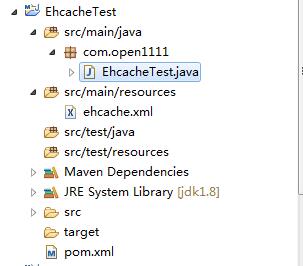
EhCache HelloWorld实现
发布时间:『 2017-03-31 10:54』 博客类别:EhCache缓存框架
EhCache最新版本是3.X 本人一直用的是2.X 比较稳定 功能足够用;
所以还是用2.X版本;
我们新建一个Maven项目,
pom.xml里引入 ehcache支持;
<dependency> <groupId>net.sf.ehcache</groupId> <artifactId>ehcache</artifactId> <version>2.10.3</version> </dependency>
ehcache.xml配置文件
<?xml version="1.0" encoding="UTF-8"?> <ehcache> <!-- 磁盘存储:将缓存中暂时不使用的对象,转移到硬盘,类似于Windows系统的虚拟内存 path:指定在硬盘上存储对象的路径 --> <diskStore path="C:\ehcache" /> <!-- defaultCache:默认的缓存配置信息,如果不加特殊说明,则所有对象按照此配置项处理 maxElementsInMemory:设置了缓存的上限,最多存储多少个记录对象 eternal:代表对象是否永不过期 overflowToDisk:当内存中Element数量达到maxElementsInMemory时,Ehcache将会Element写到磁盘中 --> <defaultCache maxElementsInMemory="100" eternal="true" overflowToDisk="true"/> <cache name="a" maxElementsInMemory="100" eternal="true" overflowToDisk="true"/> </ehcache>
我们再新建一个测试类:
package com.open1111;
import net.sf.ehcache.Cache;
import net.sf.ehcache.CacheManager;
import net.sf.ehcache.Element;
public class EhcacheTest {
public static void main(String[] args) {
// 根据ehcache.xml配置文件创建Cache管理器
CacheManager manager=CacheManager.create("./src/main/resources/ehcache.xml");
Cache c=manager.getCache("a"); // 获取指定Cache
Element e=new Element("java1234","屌"); // 实例化一个元素
c.put(e); // 把一个元素添加到Cache中
Element e2=c.get("java1234"); // 根据Key获取缓存元素
System.out.println(e2);
System.out.println(e2.getObjectValue());
c.flush(); // 刷新缓存
manager.shutdown(); // 关闭缓存管理器
}
}运行输出:
SLF4J: Failed to load class "org.slf4j.impl.StaticLoggerBinder".
SLF4J: Defaulting to no-operation (NOP) logger implementation
SLF4J: See http://www.slf4j.org/codes.html#StaticLoggerBinder for further details.
[ key = java1234, value=屌, version=1, hitCount=1, CreationTime = 1490928074754, LastAccessTime = 1490928074764 ]
屌
目录结构:

详细讲解 请关注java1234的 一头扎进Ehcache 视频教程
关键字:
EhCache
上一篇:EhCache缓存框架简介
下一篇:EhCache 常用配置项详解


Java1234_小锋
(知识改变命运,技术改变世界)
- Java核心基础(145)
- QQ第三方登录(6)
- mybatis-plus(20)
- Mycat(30)
- Layui(2)
- Mysql(2)
- Docker(35)
- Dubbo(7)
- 007项目(0)
- SVN(22)
- SpringCloud(33)
- Tomcat(6)
- 支付宝接口(3)
- NodeJs(1)
- IDEA(24)
- SpringBoot(11)
- 微信扫码登录(4)
- Git(50)
- Nginx(24)
- Vue.js(50)
- jsoup(6)
- shiro(1)
- Redis(17)
- maven(6)
- 活动(20)
- hibernate(1)
- EhCache缓存框架(4)
- webservice(10)
- CAS单点登录(7)
- elasticsearch(31)
- log4j日志(8)
- IT之路(26)
- activiti(26)
- centos(25)
- java爬虫技术(14)
- 随心生活(19)
- 网站SEO(2)
- htmlunit(10)
- httpclient(7)
- 2022年12月(1)
- 2021年10月(1)
- 2021年02月(3)
- 2020年11月(3)
- 2020年10月(4)
- 2020年09月(7)
- 2020年08月(18)
- 2020年07月(21)
- 2020年06月(37)
- 2020年05月(17)
- 2020年04月(12)
- 2020年03月(10)
- 2020年02月(14)
- 2020年01月(12)
- 2019年12月(15)
- 2019年11月(27)
- 2019年10月(5)
- 2019年09月(1)
- 2019年08月(4)
- 2019年07月(28)
- 2019年06月(16)
- 2019年05月(4)
- 2019年04月(3)
- 2019年03月(2)
- 2019年02月(7)
- 2019年01月(20)
- 2018年12月(2)
- 2018年11月(5)
- 2018年10月(30)
- 2018年09月(11)
- 2018年08月(5)
- 2018年07月(9)
- 2018年06月(4)
- 2018年05月(4)
- 2018年04月(3)
- 2018年03月(7)
- 2018年02月(6)
- 2018年01月(13)
- 2017年12月(3)
- 2017年11月(10)
- 2017年10月(1)
- 2017年09月(9)
- 2017年08月(12)
- 2017年07月(19)
- 2017年06月(21)
- 2017年05月(1)
- 2017年04月(12)
- 2017年03月(13)
- 2017年02月(12)
- 2017年01月(14)
- 2016年12月(8)
- 2016年11月(25)
- 2016年10月(16)
- 2016年09月(13)
- 2016年08月(20)
- 2016年07月(12)
- 2016年06月(36)
- 2016年05月(10)
- 2016年04月(19)
- 2016年03月(14)
- 2016年02月(23)
- 2016年01月(1)
Powered by Java1234 V3.0
Copyright © 2012-2016 Java知识分享网 版权所有